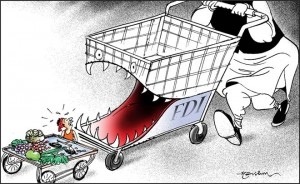From 1980 to 2012, India’s economy has come a long way. The regulatory structure of the economy and many sectors have seen a vast change. Along with a prominent services sector, the financial markets have developed too.They are more cushioned than before to face triggers in the economy.Foreign exchange reserves are larger and exchange rates are more market determined.
In 1991 , India had an administered rate, private inflows were less and there were no dollars left for imports and hence new credits were not allowed. The government was about to default and only 3 week’s imports could be supported. Dr. Manmohan Singh, the finance minister that time brought in liberalization as economic reforms and trade was more globalized. In 2012, rupee has been allowed to depreciate and global firms are allowed to participate unlike in 1990’s. Indian financial system now consists of markets allowing borrowings by large corporations and global firms.
 Lately with the global crises hitting every part of the world, India stands no different except the range of crisis differs.India is facing some major changes like slow growth, high inflation, falling of the rupee, slowdown of Foreign Investment Inflow and Balance of payment problems.The central bank of India (Reserve Bank of India) has intervened on many occasions trying to correct the money inflow and outflow within the market and the banks but this month saw an announcement of measures that would affect and help in reviving the economy and combating inflation. Towards the end of 2011, the Government initiated the introduction of 51% Foreign Direct Investment (FDI) in retail sector but due to pressure from fellow coalition parties and the opposition, the decision was rolled back. On 14 September 2012,Government of India allowed Foreign Direct Investment; in aviation upto 49%, in Broadcast sector upto 74%, in multi-brand retail upto 51% and in single-brand retail upto 100%The announcement of Foreign Direct Investment (FDI) was more to help curb inflation and modernise the sector.
Lately with the global crises hitting every part of the world, India stands no different except the range of crisis differs.India is facing some major changes like slow growth, high inflation, falling of the rupee, slowdown of Foreign Investment Inflow and Balance of payment problems.The central bank of India (Reserve Bank of India) has intervened on many occasions trying to correct the money inflow and outflow within the market and the banks but this month saw an announcement of measures that would affect and help in reviving the economy and combating inflation. Towards the end of 2011, the Government initiated the introduction of 51% Foreign Direct Investment (FDI) in retail sector but due to pressure from fellow coalition parties and the opposition, the decision was rolled back. On 14 September 2012,Government of India allowed Foreign Direct Investment; in aviation upto 49%, in Broadcast sector upto 74%, in multi-brand retail upto 51% and in single-brand retail upto 100%The announcement of Foreign Direct Investment (FDI) was more to help curb inflation and modernise the sector.  The minimum investment sought is $100 million by anyone who wishes to enter India of which $50 million must be spent at the source, which are our villages. This news was not well received by all political parties( especially since most of the opposition parties believe more in demonstrations) and led to a complication of introducing a term to farmers, local traders and consumers. A Polit Bureau statement issued by the Communist Party of India (Marxist) said that by this policy announcement, the Manmohan Singh government had taken the single biggest step of destroying the livelihood of those engaged in retail trade.
The minimum investment sought is $100 million by anyone who wishes to enter India of which $50 million must be spent at the source, which are our villages. This news was not well received by all political parties( especially since most of the opposition parties believe more in demonstrations) and led to a complication of introducing a term to farmers, local traders and consumers. A Polit Bureau statement issued by the Communist Party of India (Marxist) said that by this policy announcement, the Manmohan Singh government had taken the single biggest step of destroying the livelihood of those engaged in retail trade.
However, C Rangarajan, chairman of the Prime Minister’s Economic Advisory Council, said, “India is a vast country. There will be a place for large retailers as well as small farmers.”  He said that these stores and street hawkers could become a part of the modern retail change story if they could be assimilated into organised retail or were upgraded through infusion of capital, better training and franchises. This holds true since in order to be a part of a global economy, local traders and farmers need to upgrade rather than dealing in trade traditionally since the latter will get them more costs and less profits.He advised farmers to form groups so that they could be in a better position to bargain with the modern retailers.
He said that these stores and street hawkers could become a part of the modern retail change story if they could be assimilated into organised retail or were upgraded through infusion of capital, better training and franchises. This holds true since in order to be a part of a global economy, local traders and farmers need to upgrade rather than dealing in trade traditionally since the latter will get them more costs and less profits.He advised farmers to form groups so that they could be in a better position to bargain with the modern retailers.
One should realize that the crux of infusing policies is to revive the sleeping or falling economy. Dr. Manmohan Singh used his economic reforms in 1980s when India faced its worst and got the country back to normalcy. In 2012, the situation calls for a greater global participation and competition so as to curb inflation by lowering the prices.
© 2012 Deena Zaidi. All rights reserved.
